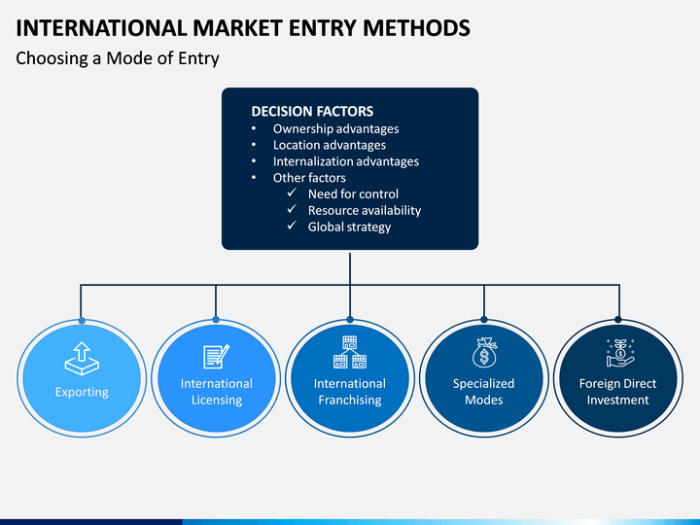Kicking off with Market Entry Strategies, this paragraph sets the stage for exploring different approaches to entering new markets, providing insights into the dynamic world of business expansion.
Overview of Market Entry Strategies
Market entry strategies refer to the methods or approaches that a company uses to enter a new market and establish a presence. Choosing the right market entry strategy is crucial for the success of a business in a new market.
Examples of Market Entry Strategies
- Exporting: Selling products or services to customers in a foreign market.
- Licensing: Allowing a foreign company to use your intellectual property in exchange for royalties.
- Joint Venture: Partnering with a local company in the foreign market to share resources and risks.
- Franchising: Granting the rights to use your business model and brand to a franchisee in a new market.
Importance of Choosing the Right Market Entry Strategy
Choosing the right market entry strategy is essential for a company’s success in a new market. It can impact factors such as market penetration, control over operations, risk management, and profitability. By selecting the most suitable strategy, a company can effectively navigate the challenges and opportunities of entering a new market.
Market Research for Market Entry

Market research plays a crucial role in developing effective market entry strategies. By gathering data and insights about the target market, companies can make informed decisions and minimize risks when entering new markets.
Methods for Conducting Market Research for Market Entry
- Conducting surveys and questionnaires to gather information directly from potential customers.
- Analyzing existing market reports and data to understand market trends and consumer behavior.
- Utilizing focus groups or interviews to gain qualitative insights into customer preferences and needs.
- Exploring online resources and databases to gather information about competitors and market dynamics.
Role of Market Research in Identifying Opportunities and Challenges
Market research helps in identifying opportunities by uncovering unmet customer needs, emerging trends, and gaps in the market that a company can capitalize on. It also helps in understanding the competitive landscape and potential challenges that may arise, allowing companies to develop strategies to address them proactively.
Types of Market Entry Strategies

When entering a new market, companies have various strategies to choose from based on their goals and resources. Each type of market entry strategy comes with its own set of advantages and disadvantages. Let’s explore some of the common strategies and real-world examples of companies successfully implementing them.
Exporting
- Advantages:
- Low initial investment
- Quick entry into the market
- Disadvantages:
- Dependence on local distributors
- Limited control over the marketing and sales process
Example: Nike exports its products to various countries around the world, allowing them to reach a global audience.
Licensing, Market Entry Strategies
- Advantages:
- Low risk and investment for the licensor
- Access to local market knowledge of the licensee
- Disadvantages:
- Loss of control over the product and brand
- Potential for conflicts with the licensee
Example: Coca-Cola licenses its bottling operations to local partners in different countries, allowing them to adapt to local tastes and preferences.
Franchising
- Advantages:
- Rapid expansion with minimal investment
- Benefit from the franchisee’s local knowledge and expertise
- Disadvantages:
- Loss of control over franchisee operations
- Shared profits with franchisees
Example: McDonald’s uses franchising to expand its presence globally, maintaining consistency in its offerings while adapting to local preferences.
Joint Ventures
- Advantages:
- Shared risks and costs with the partner
- Access to partner’s local expertise and resources
- Disadvantages:
- Potential conflicts between partners
- Shared decision-making and profits
Example: Sony and Ericsson formed a joint venture to develop and manufacture mobile phones, combining their strengths to compete in the market.
Factors to Consider in Market Entry
When choosing a market entry strategy, companies must carefully consider various key factors that can greatly impact their success in entering a new market. These factors include political, economic, social, and technological aspects that play a crucial role in determining the feasibility and effectiveness of the chosen strategy. Additionally, understanding local regulations and cultural nuances is vital for navigating the market entry process smoothly and building strong relationships with stakeholders.
Political Factors
Political stability, government regulations, trade policies, and taxation systems are essential factors to consider when entering a new market. Companies need to assess the political landscape of the target market to ensure compliance with regulations and minimize potential risks.
Economic Factors
Economic conditions such as GDP growth, inflation rates, exchange rates, and market demand are crucial considerations for market entry strategies. Companies need to analyze the economic environment of the target market to make informed decisions on pricing, investment, and market positioning.
Social Factors
Social factors like cultural norms, consumer behavior, demographics, and lifestyle trends can significantly impact market entry strategies. Companies need to conduct thorough market research to understand the preferences and needs of the target market’s population to tailor their products or services accordingly.
Technological Factors
Technological advancements, infrastructure development, and digital trends play a key role in shaping market entry decisions. Companies need to leverage technology to enhance their competitive advantage, streamline operations, and reach their target audience effectively in the new market.
Regulatory and Cultural Aspects
Understanding local regulations, business practices, and cultural norms is essential for successful market entry. Companies need to adapt their strategies to align with the legal framework and cultural sensitivities of the target market to build trust and credibility among local stakeholders.












